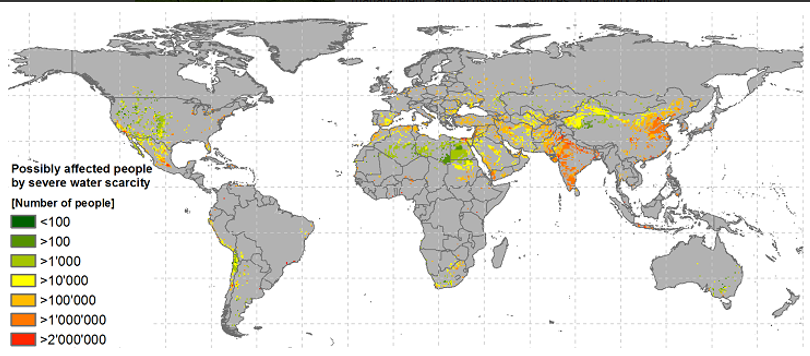The successful completion of the fast-track analysis under the global Water Futures and Solutions (WFaS) initiative, is a major achievement of the Water (WAT) Program. The analysis has yielded the first set of multi-model, quantified scenarios of water demand with a focus on the domestic, industrial, and energy sectors.
The WAT program carried out several collaborative projects in 2015 to improve understanding of local water issues related to food, energy, transboundary water management, and ecosystem services. The work aimed to identify joint solutions working across sectors and scales. In practical terms this means that WAT now covers all aspects of water use [1][2][3].
The WFaS fast-track analysis constitutes the first comprehensive, multi-model assessment of water availability and demand, with full consistency of climate, energy, and land-use scenarios.
The fast tracking uses ongoing research to develop a set of (preliminary) scenarios with quantitative water projections consistent with global scenario processes in other sectors [4][5]. This work is based on the Shared Socioeconomic Pathways and the Representative Concentration Pathways and associated climate model projections that were developed for the Intergovernmental Panel on Climate Change Fifth Assessment Report and beyond. The scenarios also take into account changes in population and gross domestic product. As part of the assessment, water insecurity hot-spots have been identified, with a focus on the occurrence of joint water, energy, and food insecurity. The results indicate that global demand for water could more than double by 2050, increasing pressure on already scarce water resources.
WFaS also published interim reports on the conceptual framework for applied scenarios, building water-use scenarios, and a global hydro-economic classification of hydrological challenges and socioeconomic coping capacity.
 © IIASA
© IIASA
Figure 1. Potential population under severe water scarcity in 2050 - Middle of the Road Scenario
References
[1] Cosgrove W & Loucks D (2015). Water management: Current and future challenges and research directions. Water Resource Research, 51: 4823–4839.
[2] Fischer G, Hizsnyik E, Tramberend S & Wiberg D (2015). Towards indicators for water security - A global hydro-economic classification of hydrological challenges and socio-economic coping capacity. In: IIASA Interim Report IR-15-01. IIASA, Laxenburg.
[3] Magnuszewski P, Wiberg D, Cosgrove W, Fischer G, Flörke M, Hizsnyik E, Pahl-Wostl C, Segrave A, Toth G, Tramberend S, van Vliet M, Yillia P & Zeller D (2015). Conceptual framework for scenarios development in the Water futures and Solutions project. In: IIASA Interim Report IR-15-011. IIASA, Laxenburg.
[4] Tramberend S, Wiberg D, Wada Y, Flörke M, Fischer G, Satoh Y, Yillia P, van Vliet M, Hizsnyik E, Nava Jimenéz LF & Blokker M (2015). Building Global Water Use Scenarios. In: IIASA Interim Report IR-15-014. IIASA, Laxenburg.
[5] Wada Y, Flörke M, Hanasaki N, Eisner S, Fischer G, Tramberend S, Satoh Y, van Vliet M, Yillia P, Ringler C, Burek P & Wiberg D (2016). Modeling global water use for the 21st century: Water Futures and Solutions (WFaS) initiative and its approaches. Geoscientific Model Development, 8: 6417–6521.
Collaborators
International Water Association (IWA)
World Water Council (WWC)
Asian Development Bank (ADB)
Austrian Development Agency (ADA) , Austria
Bibliotheca Alexandrina, Egypt
Center for Environmental Systems Research (CESR), University of Kassel, Germany
Commonwealth Scientific and Industrial Research Organisation (CSIRO), Australia
Institute of Rural Management Anand (IRMA), India
Institute of Geographic Sciences and Natural; Resources Research (CAS), China
Institute of Water Resources and Hydropower Research (IWHR), China
International Food Policy Research Institute (IFPRI)
International Water Management Institute (IWMI)
Joint Research Centre (JRC) – European Commission
Korean National Committee, Korea
KWR Watercycle Research Institute, Netherlands
National Institute for Environmental Studies (NIES), Japan
National Institute of Hydrology (NIH), India
National Natural Science Foundation of China (NSFC)
University of Oxford, United Kingdom
Potsdam Institute for Climate Impact Research (PIK), Germany
South African Water Research Commission (WRC)
The City University of New York (CUNY), USA
Utrecht University, Netherlands; Wageningen University, Netherlands
Lahore University of Management Sciences, Pakistan
African Development Bank Group (AfDB), Tunisia
Swiss NEWATER / SymbioSwiss, Switzerland
The World Bank, US
Food and Agriculture Organisation of the UN (FAO), Italy
Ministry of Economy, Family and Youth, Austria
Ministry for Agriculture, Forestry, Environment and Water Management, Austria
UN-Water
Global Water Partnership (GWPS)
